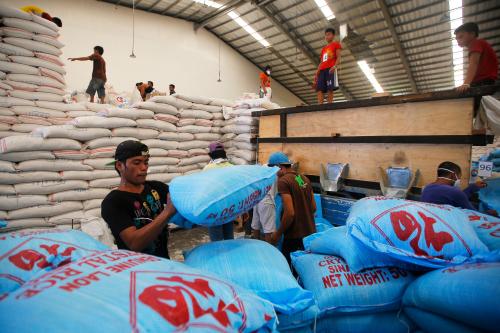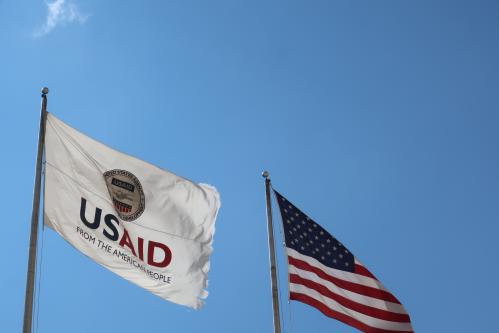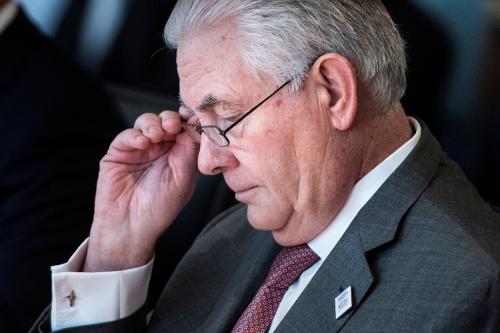On April 13, United States Agency for International Development (USAID) made public its near final internal redesign. The agency followed a constructive process that has produced a rational organizational restructuring.
THE PROCESS FOR REDESIGNING USAID
Development best practice calls for those affected to play a significant role in the planning of a new program and for relevant stakeholders to be consulted. USAID mostly followed this script. A few senior political appointees provided overall leadership, with the specifics designed by some 100 career staff who ran a process that included reviewing numerous outside reports and consultations with the development community. Yet, beyond the 100, few of the career staff who will have to implement and function under the new structure were involved.
The proposed restructuring follows a certain logic as to policies and programs that should be connected and elevated. Ideas discussed in recent years within the agency and in relevant reports and public fora are featured, but in various areas the plan plows new ground.
STRENGTHENING USAID’s Leadership
Many of us in the development community have been calling for USAID to have a second deputy, both to share the management load and to have a third senior official who can represent the agency. The redesign proposal goes one step further, leaving the agency with one deputy but adding two associate administrators who would be equivalent to undersecretaries at the Department of State. Therefore, the agency would have four senior officials—especially valuable given the need for high-level representation at inter-agency deliberations, with Congress, with the development community, and at international gatherings.
MERGING RELIEF, RESILIENCE, AND RESPONSE
Officials in charge of the redesign are answering the call to break down the artificial divide between food assistance and non-food relief by merging the Office of U.S. Foreign Disaster Assistance and the Office of Food for Peace. But not only does the proposed structure bring the two offices together in a new Bureau of Humanitarian Assistance, it joins that bureau with two related new bureaus, one on conflict prevention and stabilization and another on resilience and food security, under an Associate Administrator for Relief, Resilience, and Response (R3). So, at a time when fragility is the fundamental challenge to development, and a principal issue of security and foreign policy, the plan brings together under one senior official various pieces that must function together to address state fragility and instability. It thereby enhances USAID’s ability to develop more comprehensive approaches to fragility. Fragility requires interaction with the departments of State and Defense and the National Security Council, and this configuration provides the agency with a senior level voice in these complex interagency processes.
How will this structure actually function? For example, how do democracy, human rights, and governance (DRG) fit in? The DRG center would be located elsewhere in the new Bureau for Development, Democracy and Innovation (DDI), but DRG issues are core to fragility, so how will they plug into the work of the R3 bureau? Beyond that, they are important for U.S. leadership globally, so does their location as a center for excellent along with various other technical centers provide them the prominence and access they deserve?
A similar question of connectedness to relevant programs and offices involves nutrition and WASH (water, sanitation, and hygiene). Nutrition involves food relief and food security, each located in separate bureaus under the associate administrator for R3. Yet health, which will reside in its own bureau, is interlinked with nutrition. How do these pieces connect? One answer is that nutrition, like other crosscutting issues, will have an intra-agency nutrition leadership council to knit the pieces together. The drafting of a nutrition strategy would help as well.
DEVELOPMENT, DEMOCRACY, INNOVATION
DDI would join certain technical expertise, program design, and innovative processes from the USAID Global Lab to make these capabilities available throughout the agency, with special emphasis on support for field missions. While the value of this conglomeration will depend on how it is structured and managed, at its best one can imagine this as a beehive, breaking down traditional sector stovepipes and buzzing with knowledge, ideas, and innovation disseminated through the agency.
One chasm that will need to be bridged is that this bureau will house only some of the agency’s centers of excellence—technical expertise on gender, DRG, education, energy, environment, and private sector. Other centers of expertise will reside in sector specific bureaus. How to break down sector silos and ensure that programs are comprehensive will be a challenge.
The plan says nothing about science and technology, an area in which USAID has a notable record—recall USAID’s role in the green revolution. It would seem this new bureau would be the logical home for a renewed focus on science and technology.
POLICY, BUDGET, PERFORMANCE
The proposed Bureau for Policy, Resources and Performance (PRP) is a return to the best of the past. In the late 1970s and early 1980s, policy and budget were joined into a single bureau. As is known but not often practiced, budgets should flow from policy. For the past several decades, the two have been separated in USAID, with budgets too often driving policy. In that earlier period, Assistant Administrator for Program and Policy Coordination Alex Shakow was in essence the third ranking official of the agency and could go to interagency meetings and Capitol Hill to comprehensively discuss policy and budget. Bring the two together, along with the accountability functions of evaluation and learning, is the way to build a knowledge-based agency.
The good news is this new bureau would report to a new senior level associate administrator. Yet a major question about the broader configuration remains. As suggested by the awkward title of this position—Associate Administrator for Operations—this position would also oversee a second bureau covering management functions of security and human resources. The problem is policy/budget and management are different functions. Policymaking and budgeting encompass where and how programming should be prioritized, and the associate administrator would lead the agency on these issues and be a principal external representative and spokesperson. While good management is critical to the functioning of the agency, it is focused internally on the nitty gritty of operations and requires different skills and expertise. A better alignment would be for management to report to the deputy administrator, who typically is responsible for day-to-day operations.
Pairing the new Bureau of Development, Democracy and Innovation with the Bureau for Policy, Resources and Performance might work better. There is natural linkage of technical expertise, program design, and innovation with policy—they need to be closely connected and should inform each other.
Another change worth considering would be to place the Bureau for Legislative and Public Affairs under this associate administrator, since working with Congress on budget issues is critical to the business of the agency, and policy justifies budget.
Therefore, a more effective configuration might be a pairing of budget and policy, technical expertise and innovation, and legislative affairs. Such an arrangement would integrate these related functions and empower the associate administrator to be a strong representative for the agency at the highest levels.
IMPORTANCE OF PERSONNEL
An organization is only as good as its people. Henrietta Fore, USAID administrator in the last few years of the George W. Bush administrator, recognized this in launching the Development Leadership Initiative. With 1,025 foreign service officers remaining following a major downsizing in the 1990s, the agency set a goal to increase that number to 1,850. The Obama administration continued the initiative, and the number reached about 1,800 in 2016. Soon after taking office, the Trump administration instituted a hiring freeze at the Department of State and USAID. That freeze was lifted in March, by which time the number of foreign service officers at USAID had fallen to 1,685.
To achieve the goal of the redesign plan, rather than the commendable ongoing effort to improve the current USAID human resource structure, the agency needs an entirely new human resources plan. That can best be developed through a collaboration with experienced experts at the National Academy for Public Administration, a point I explore in Aid effectiveness: Reform in the new administration and Congress.
FINALIZING THE PLAN
Administrator Mark Green and his USAID colleagues should be commended for producing a restructuring plan that is rational and innovative, and for making it public before it is finalized. They have started an intensive consultation process, within USAID, inside the administration, with Congress, and with interested outside communities. As suggested by this analysis, the basic structure is sound but could benefit from a few modifications.
With the expectation that this final stage in the redesign process will be constructive and smart, USAID could be near the launch of an organizational restructuring that will make it a more effective agency in pursuit of its mission of advancing inclusive economic growth and alleviating poverty.
The Brookings Institution is committed to quality, independence, and impact.
We are supported by a diverse array of funders. In line with our values and policies, each Brookings publication represents the sole views of its author(s).







Commentary
A first look at USAID’s redesign plan
April 18, 2018